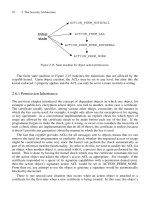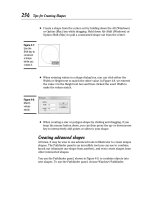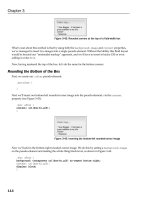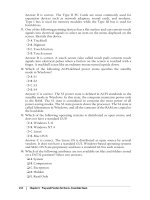Java Design Patterns A Tutorial phần 4 doc
Bạn đang xem bản rút gọn của tài liệu. Xem và tải ngay bản đầy đủ của tài liệu tại đây (640.41 KB, 28 trang )
85
In other words, all Java Beans have the same interface used by the builder program, and you can
substitute any Bean for any other and still manipulate its properties using the same convenient
interface. The actual program you construct uses these classes in a conventional way, each having
its own rather different methods. However, from the builder's point of view, they all appear to be
the same.
Consequences of the Bridge Pattern
Using the Bridge pattern has the following consequences:
1. The Bridge pattern is intended to keep the interface to your client program constant while
allowing you to change the actual kind of class that you display or use. This can help you
to avoid recompiling a complicated set of user interface modules and require only that
you recompile the bridge itself and the actual end display class.
2. You can extend the implementation class and the Bridge class separately and usually
without their having much interaction with each other.
3. You can hide implementation details from the client program much more easily.
lightbulb Thought Question
1. In plotting a stock's performance, you usually display the price and price-earnings ratio
over time, while in plotting a mutual fund, you usually show the price and the earnings
per quarter. Suggest how you can use a Bridge pattern to do both.
Programs on the CD-ROM
86
Program Description
Bridge\BasicBridge\
ProductDisplay.java
Displays a list box and a table of unsorted product names
Bridge\SortBridge\
SproductDisplay.java
Displays a list box and a table of sorted product names.
Bridge\TreeBridge\
Tproductdisplay.java
Displays a tree list and a table of sorted product names and
amounts.
87
Chapter 11. The Composite Pattern
Programmers often develop systems in which a component may be an individual object or may
represent a collection of objects. The Composite pattern is designed to accommodate both cases.
You can use it to build part-whole hierarchies or to construct data representations of trees. In
summary, a composite is a collection of objects, any one of which may be either a composite or a
primitive object. In tree nomenclature, some objects may be nodes with additional branches, and
some may be leaves.
A problem that develops is the dichotomy between having a single, simple interface to access all
of the objects in a composite and the ability to distinguish between nodes and leaves. Nodes have
children and can have children added to them, while leaves do not at the moment have children
and in some implementations may be prevented from having children added to them.
Some authors have suggested creating a separate interface for nodes and leaves, where a leaf could
have the following methods:
public String getName();
public String getValue();
A node could have the following methods:
public Enumeration elements();
public Node getChild(String nodeName);
public void add(Object obj);
public void remove(Object obj);
This then leaves us with the programming problem of deciding which elements will be which
when we construct the composite. However, Design Patterns suggests that each element should
have the same interface, whether it is a composite or a primitive element. This is easier to
accomplish, but we are left with the question of what the getChild operation should accomplish
when the object is actually a leaf.
Java makes this quite easy for us, since every node or leaf can return an Enumeration of the
contents of the Vector where the children are stored. If there are no children, the
hasMoreElements method returns false at once. Thus if we simply obtain the Enumeration from
each element, we can quickly determine whether it has any children by checking the
hasMoreElements method.
Just as difficult is the issue of adding or removing leaves from elements of the composite. A
nonleaf node can have child leaves added to it, but a leaf node cannot. However, we would like all
of the components in the composite to have the same interface. Attempts to add children to a leaf
node must not be allowed, and we can design the leaf node class to throw an exception if the
program attempts to add to such a node.
An Implementation of a Composite
Let's consider a small company that was started by one person who got the business going. He was,
of course, the CEO, although he might have been too busy to think about it at first. Then he hired
a couple of people to handle the marketing and manufacturing. Soon each of them hired some
assistants to help with advertising, shopping, and so on, and they became the company's first two
88
vice-presidents. As the company's success continued, thefirm continued to grow until it had the
organizational chart we see in Figure 11.1
.
Figure 11.1. A typical organizational chart.
Computing Salaries
Now, if the company is successful, each of these company members receives a salary, and we
could at any time ask for the cost of the control span of any employee to the company. We define
this control span cost as the salary of that person as well as the combined salaries of all of his or
her subordinates. Here is an ideal example for a composite:
• The cost of an individual employee is that employee's salary (and benefits).
• The cost of an employee who heads a department is that employee's salary plus the
salaries of all employees that the employee controls.
We would like a single interface that will produce the salary totals correctly, whether or not the
employee has subordinates.
public float getSalaries();
At this point, we realize that the idea of all Composites having the same standard method names in
their interfaces is probably naïve. And, in fact, we'd prefer that the public methods be related to
the kind of class that we are actually developing. So rather than have generic methods such as
getValue, we'll use getSalaries.
The Employee Classes
We could now imagine representing the company as a Composite made up of nodes: managers
and employees. We could use a single class to represent all employees, but since each level might
have different properties, defining at least two classes might be more useful: Employees and
Bosses. Employees are leaf nodes and cannot have employee nodes under them; Bosses are nodes
that may have Employee nodes under them.
We'll start with the AbstractEmployee class and derive our concrete employee classes from it.
89
public abstract class AbstractEmployee {
protected String name;
protected long salary;
protected Employee parent = null;
protected boolean leaf = true;
public abstract long getSalary();
public abstract String getName();
public abstract boolean add(Employee e)
throws NoSuchElementException;
public abstract void remove(Employee e)
throws NoSuchElementException;
public abstract Enumeration subordinates();
public abstract Employee getChild(String s);
public abstract long getSalaries();
public boolean isLeaf() {
return leaf;
}
}
Our concrete Employee class stores the name and salary of each employee and allows us to fetch
them as needed.
public Employee(String _name, float _salary) {
name = _name;
salary = _salary
leaf = true;
}
//
public Employee(Employee _parent, String _name, float _salary) {
name = _name;
salary = _salary;
parent = _parent;
leaf = true;
}
//
public float getSalary() {
return salary;
}
//
public String getName() {
return name;
}
The Employee class must have concrete implementations of the add, remove, getChild, and
subordinates methods classes. Since an Employee is a leaf, all of these will return some sort of
error indication. For example, subordinates could return null, but programming will be more
consistent if it returns an empty Enumeration.
public Enumeration subordinates() {
return v.elements();
}
The add and remove methods must generate errors, since members of the basic Employee class
cannot have subordinates.
90
public boolean add(Employee e) throws NoSuchElementException {
throw new NoSuchElementException("No subordinates");
}
public void remove(Employee e) throws NoSuchElementException {
throw new NoSuchElementException("No subordinates");
}
The Boss Class
Our Boss class is a subclass of Employee and allows us to store subordinate employees as well.
We'll store them in a Vector called subordinates, which we return through an Enumeration. Thus
if a particular Boss has temporarily run out of Employees, the Enumeration will be empty.
public class Boss extends Employee {
Vector employees;
public Boss(String _name, long _salary) {
super(_name, _salary);
leaf = false;
employees = new Vector();
}
//
public Boss(Employee _parent, String _name, long _salary) {
super(_parent, _name, _salary);
leaf = false;
employees = new Vector();
}
//
public Boss(Employee emp) {
//promotes an employee position to a Boss
//and thus allows it to have employees
super(emp.getName(), emp.getSalary());
employees = new Vector();
leaf = false;
}
//
public boolean add(Employee e) throws NoSuchElementException {
employee.add(e);
return true;
}
//
public void remove(Employee e) throws NoSuchElementException {
employees.removeElement(e);
}
//
public Enumeration subordinates() {
return employees.elements();
}
If you want to get a list of employees of a given supervisor, you can obtain an Enumeration of
them directly from the subordinates Vector. Similarly, you canuse this same Vector to return a
sum of salaries for any employee and his or her subordinates.
91
public long getSalaries() {
long sum = salary;
for (int i = 0; i < employees.size(); i++) {
sum += ((Employee)employees.elementAt(i)).getSalaries();
}
return sum;
}
Note that this method starts with the salary of the current Employee and then calls the getSalaries
method on each subordinate. This is, of course, recursive, and any employees who themselves
have subordinates will be included. A diagram of these classes in shown in Figure 11.2
.
Figure 11.2. The AbstractEmployee class and how Employee and Boss are derived
from it.
Building the Employee Tree
We start by creating a CEO Employee and then add that employee's subordinates and their
subordinates as follows:
private void makeEmployees() {
TEAMFLY
Team-Fly
®
92
prez = new Boss("CEO", 200000);
prez.add(marketVP = new Boss("Marketing VP", 100000));
prez.add(prodVP = new Boss("Production VP", 100000));
marketVP.add(salesMgr = new Boss("Sales Mgr", 50000));
marketVP.add(advMgr = new Boss("Advt Mgr", 50000));
//add salesmen reporting to sales manager
for (int i = 0; i < 5; i++)
salesMgr .add(new Employee("Sales " + i, rand_sal(30000)));
advMgr.add(new Employee("Secy", 20000));
prodVP.add(prodMgr = new Box("Prod Mgr", 40000));
prodVP.add(shipMgr = new Boss("Ship Mgr", 35000));
//add manufacturing staff
for (int i = 0; i < 4; i++)
prodMgr.add(new Employee("Manuf " + i, rand_sal(25000)));
//add shipping clerks
for (int i = 0; i < 3; i++)
shipMgr.add(new Employee("ShipClrk " + i, rand_sal(20000)));
}
Once we have constructed this Composite structure, we can load a visual JTree list by starting at
the top node and calling the addNode method recursively until all of the leaves in each node are
accessed.
private void addNodes(DefaultMutableTreeNode pnode, Employee emp) {
DefaultMutableTreeNode node;
Enumeration e = emp.subordinates();
if (e != null) {
while (e.hasMoreElements()) {
Employee newEmp = (Employee)e.nextElement();
node = new DefaultMutableTreeNode(newEmp.getName());
pnode.add(node);
addNodes(node, newEmp);
}
}
}
The final program display is shown in Figure 11.3.
Figure 11.3. The corporate organization shown in a TreeList control.
93
In this implementation, the cost (sum of salaries) is shown in the bottom bar for any employee you
click on. This simple computation calls the getChild method recursively to obtain all of the
subordinates of that employee.
public void valueChanged(TreeSelectionEvent evt) {
TreePath path = evt.getPath();
String selectedTerm = path.getLastPathComponent().toString();
Employee emp = prez.getChild(selectedTerm);
if (emp != null)
cost.setText(new Float(emp.getSalaries()).toString());
}
Self-Promotion
94
Sometimes, an Employee will stay in a current job but acquire new subordinates. For example, a
Salesman might be asked to supervise sales trainees. For such a case, we can conveniently provide
a Boss constructor that creates a Boss from an Employee.
public Boss(Employee emp) {
//promotes an employee position to a Boss
//and thus allows it to have employees
super(emp.getName(), emp.getSalary());
employees = new Vector();
leaf = false;
}
The problem of replacing the Employee instance with the Boss instance means replacing a Vector
element with a new one using the setElementAt method.
Doubly Linked List
In the previous implementation, we keep a reference to each subordinate in the Vector in each
Boss class. This means that you can move down the chain from the CEO to any employee, but that
there is no way to move back up to identify an employee's supervisor. This is easily remedied by
providing a constructor for each AbstractEmployee subclass that includes a reference to the parent
node.
public Employee(Employee _parent, String _name,
float _salary) {
name = _name;
salary = _salary;
parent = _parent; //save parent node
leaf = true;
}
Then you can quickly walk up the tree to produce a reporting chain.
list.add (emp.getName()); //employee name
while(emp.getParent() != null) {
emp = emp.getParent(); //get boss
list.add (emp.getName());
}
This is shown in Figure 11.4.
Figure 11.4. The tree list display of the composite, with a display of the parent
nodes on the right.
95
Consequences of the Composite Pattern
The Composite pattern allows you to define a class of hierarchy of simple objects and more-
complex composite objects so that they appear to be the same to the client program. Because of
this simplicity, the client can be that much simpler, since nodes and leaves are handled in the same
way.
The Composite pattern also makes it easy for you to add new kinds of components to your
collection, as long as they support a similar programming interface. On the other hand, this has the
disadvantage of making your system overly general. You might find it harder to restrict certain
classes, where this would normally be desirable.
A Simple Composite
The intent of the Composite pattern is to allow you to construct a tree of various related classes,
even though some have different properties than others and some are leaves that do not have
children. However, for very simple cases you can sometimes use a single class that exhibits both
parent and leaf behavior. In the SimpleComposite example, we create an Employee class that
always contains the Vector employees. This Vector of employees will either be empty or be
populated, and this determines the nature of the values that are returned from the getChild and
remove methods. In this simple case, you do not throw exceptions, and you always allow leaf
nodes to be promoted to have child nodes. In other words, you always allow the execution of the
add method.
96
While you might not regard this automatic promotion as a disadvantage, in a system that has a
very large number of leaves, keeping a Vector initialized and unused in each leaf node is wasteful.
When there are relatively few leaf nodes, this is not a serious problem.
Composites in Java
In Java, you will note that the DefaultMutableTreeNode class we use to populate the JList pane is,
in fact, just such a simple composite pattern. You will also find that the Composite describes the
hierarchy of JFrame, JPanel, and JComponents in any user interface program. JFrames, Jtoolbars,
and JPanels are all containers, and each may contain any number of other containers.
Any container may then contain components such as JButtons, JCheckboxes, and JTextPanels,
each of which is a leaf node that cannot have further children. They may also contain JLists and
JTables that may be treated as leaf nodes or that may contain further graphical components. You
can walk down the Composite tree using the getComponent method and up the Composite tree
using the getParent method.
Other Implementation Issues
Other composite implementation issues you might consider are
• Ordering of Components. In some programs, the order of the components may be
important. If that order differs somehow from the order in which they were added to the
parent, then the parent must doadditional work to return them in the correct order. For
example, you might sort the original Vector alphabetically and return the Enumerator to a
new sorted Vector.
• Caching results. If you often ask for data that must be computed froma series of child
components, as was done earlier with salaries, itmight be advantageous to cache these
computed results in the parent.However, unless the computation is relatively intensive
and youare quite certain that the underlying data have not changed, doingthis might not be
worth the effort.
lightbulb Thought Questions
1. A baseball team can be considered an aggregate of its individual players. How could you
use a composite to represent individual and team performance?
2. The produce department of a supermarket needs to track its sales performance by food
item. Suggest how a composite might be helpful in accomplishing this.
Programs on the CD-ROM
Programs Description
\Composite\StdComposite\
empTree.java
The Composite pattern using the Boss and Employee
classes.
97
\Composite\parentComposite\
pempTree.java
The Composite pattern using a doubly linked list to show the
reporting chain.
\Composite\SimpleComposite\
empTree.java
The SimpleComposite using just the Employee class.
98
Chapter 12. The Decorator Pattern
The Decorator pattern provides us with a way to modify the behavior of individual objects without
having to create a new derived class. Suppose we have a program that uses eight objects, but three
of them need an additional feature. You could create a derived class for each of these objects, and
in many cases this would be a perfectly acceptable solution. However, if each of these three
objects requires different features, you would have to create three derived classes. Further, if one
of the classes has features of both of the other classes, you begin to create complexity that is both
confusing and unnecessary.
For example, suppose we wanted to draw a special border around some of the buttons in a toolbar.
If we created a new derived button class, this means that all of the buttons in this new class would
always have this same new border, when this might not be our intent.
Instead, we create a Decorator class that decorates the buttons. Then we derive any number of
specific Decorators from the main Decorator class, each of which performs a specific kind of
decoration. In order to decorate a button, the Decorator would have to be an object derived from
the visual environment so that it can receive paint method calls and forward calls to other useful
graphics methods to the object that it is decorating. This is another case in which object
containment is favored over object inheritance. The Decorator is a graphical object, but it contains
the object that it is decorating. It might intercept some graphical method calls and perform some
additional computation, and then it might pass them on to the underlying object that it is
decorating.
Decorating a CoolButton
Recent Windows applications such as Internet Explorer and Netscape Navigator have a row of flat,
unbordered buttons that highlight themselves with outline borders when you move your mouse
over them. Some Windows programmers call this toolbar a CoolBar and the buttons CoolButtons.
There is no analogous button behavior in the JFC, but we can obtain that behavior by decorating a
JButton. In this case, we decorate it by drawing plain gray lines over the button borders, erasing
them.
Let's consider how to create this Decorator. Design Patterns suggests that Decorators should be
derived from some general Visual Component class and then every message for the actual button
should be forwarded from the Decorator. In Java, this is completely impractical because there are
literally hundreds of method calls in this base JComponent class that we would have to
reimplement. Instead, we derive our Decorator from the JComponent class. Then, since
JComponent itself behaves as a Container, it will forward all method calls to the components that
it contains. In this case, we simply add the button to the JComponent, and that button will receive
all of the GUI method calls that the JComponent receives.
Design Patterns suggests that classes such as Decorator should be abstract and that you should
derive all of your actual working (or concrete) Decorators from the abstract class. In this Java
implementation, this is not necessary because the base Decorator class has no public methods
other than the constructor, since all methods are of JComponent itself.
public class Decorator extends JComponent {
public Decorator (JComponent c) {
setLayout(new BorderLayout());
add("Center", c);
}
99
}
Now, let's look at how we could implement a CoolButton. All we really need to do is to draw the
button as usual from the base class and then draw gray lines around the border to remove the
button highlighting.
/** this class decorates a CoolButton so that
the borders are invisible when the mouse
is not over the button
*/
public class CoolDecorator extends Decorator {
boolean mouse_over: //true when mouse over button
JComponent thisComp;
public CoolDecorator(JComponent c) {
super(c);
mouse_over = false;
thisComp = this; //save this component
//catch mouse movements in an inner class
c.addMouseListener(new MouseAdapter() {
//set flag when mouse over
public void mouseEntered(MouseEvent e) {
mouse_over = true;
thisComp.repaint();
}
//clear flag when mouse is not over
public void mouseExited(MouseEvent e) {
mouse_over = false;
thisComp.repaint();
}
});
}
//
//paint the button
public void paint(Graphics g) {
super.paint(g); //first draw the parent button
//if the mouse is not over the button
//erase the borders
if (!mouse_over) {
Dimension size = super.getSize();
size.setColor(Color.lightGray);
g.drawRect(0, 0, size.width - 1, size.height - 1);
g.drawLine(size.width-2, 0, size.width - 2, size.height -
1);
g.drawLine(0, size.height-2, size.width - 2, size.height
- 2);
}
}
}
Using a Decorator
Now that we've written a CoolDecorator class, how do we use it? We simply create an instance of
the CoolDecorator and pass it the button that it is to decorate. We can do all of this right in the
100
constructor. Let's consider a simple program that has two CoolButtons and one ordinary JButton.
We create the layout as follows:
super ("Deco Button");
JPanel jp = new JPanel();
getContentPane().add(jp);
jp.add(new CoolDecorator(new JButton("Cbutton")));
jp.add(new CoolDecorator(new JButton("Dbutton")));
jp.add(Quit = new JButton("Quit"));
Quit.addActionListener(this);
This program is shown in Figure 12.1, with the mouse hovering over one of the buttons.
Figure 12.1. Cbutton and Dbutton are CoolButtons, which are outlined when a
mouse hovers over them. Here, Dbutton is outlined.
Now that we see how a single decorator works, what about multiple decorators? Suppose that we
want to decorate our CoolButtons with another decoration, say, a red diagonal line. Since the
argument to any Decorator is just a JComponent, we could create a new Decorator with a
Decorator as its argument. Let's consider the SlashDecorator, which draws that red diagonal line.
public class SlashDecorator extends Decorator {
int x1, y1, w1, h1;
public SlashDecorator(JComponent c) {
super(c);
}
public void setBounds(int x, int y, int w, int h) {
x1 = x; y1 = y;
w1 = w; h1 = h;
super.setBounds(x, y, w, h);
}
public void paint(Graphics g) {
super.paint(g);
g.setColor(Color.red);
g.drawLine(0, 0, w1, h1);
}
}
Here, we save the size and position of the button when it is created and then use those saved
values to draw the diagonal line.
You can create the JButton with these two Decorators by just calling one and then the other.
101
jp.add(new SlashDecorator(new CoolDecorator(new JButton("Dbutton"))));
This gives us a final program that displays the two buttons, as shown in Figure 12.2.
Figure 12.2. Dbutton is decorated with a SlashDecorator.
The Class Diagram
The class diagram in Figure 12.3 shows how we derived the Decorator base class from
JComponent and how the concrete Decorators take another JComponent as an argument to
determine the visual extent of the object that they decorate.
Figure 12.3. The UML class diagram for Decorators and two specific Decorator
implementations.
Decorating Borders in Java
One problem with this particular implementation of Decorators is that it is not easy to expand the
size of the component being decorated because you add the component to a container and allow it
TEAMFLY
Team-Fly
®
102
to fill the container completely. If you attempt to draw lines outside the area of this component,
they are clipped by the graphics procedure and not drawn at all.
The JFC provides its own series of Border objects that are a kind of decorator. As with a
Decorator pattern, you can add a new Border object to any JComponent. There also is a way to
add several borders. However, unlike the Decorator pattern, the Borders are not JComponents, and
you do not have the flexibility to intercept and change specific events. In fact, it is more an
example of the Strategy pattern than a Decorator.
The JFC defines several standard Border classes, given in the following table:
Class Description
BevelBorder(n) Simple two-line bevel; can be LOWERED or RAISED.
CompoundBorder(inner, outer) Allows you to add two borders.
EmptyBorder(top, left, bottom,
right)
Provides a blank border width specified on each side.
EtchedBorder Creates an etched border.
LineBorder(width, color) Creates a simple line border.
MatteBorder Creates a matte border of a solid color or a tiled icon.
SoftBeveledBorder Creates a beveled border with rounded corners.
TitledBorder Creates a border containing a title. Used to surround
and label a JPanel.
These borders are simple to use in conjunction with the setBorder method of each JComponent.
Figure 12.4
shows a normal JButton with a 2-pixel solid-line border, combined with a 4-pixel
EmptyBorder and an EtchedBorder.
Figure 12.4. Dbutton has a 2-pixel solid line border, and Quit has a 4-pixel
EmptyBorder and an EtchedBorder.
This was created with the following simple code:
JPanel jp = new JPanel();
getContentPane().add(jp);
jp.add(Cbutton = new JButton("Cbutton"));
jp.add(Dbutton = new JButton("Dbutton"));
EmptyBorder ep = new EmptyBorder(4,4,4,4);
LineBorder lb = new LineBorder(Color.black, 2);
Dbutton.setBorder(new CompoundBorder(lb, ep));
jp.add(Quit = new JButton("Quit"));
EtchedBorder eb = new EtchedBorder();
103
Quit.addActionListener(this);
Quit.setBorder(eb);
One drawback of these Border objects is that they replace the default Insets values that determine
the spacing around the component. Note that we had to add a 4-pixel Empty Border to the Dbutton
to make it similar in size to the CButton. We did not do this for the Quit button, and it is therefore
substantially smaller than the others.
You can also affect the border around a JButton, rather like a CoolButton, using the
setBorderPainted(b) method. If b is false, the border is not drawn. You then can turn it back on
and repaint when the button receives a mouseOver event.
Nonvisual Decorators
Decorators, of course, are not limited to objects that enhance visual classes. You can add or
modify the methods of any object in a similar fashion. In fact, nonvisual objects can be easier to
decorate because there may be fewer methods to intercept and forward.
While coming up with a single example is difficult, a series of Decorators do occur naturally in the
java.io classes. Note the following in the Java documentation:
The class FilterInputStream itself simply overrides all methods of InputStream with versions that
pass all requests to the underlying input stream. Subclasses of FilterInputStream may further
override some of these methods as well as provide additional methods and fields.
The FilterInputStream class is thus a Decorator that can be wrapped around any input stream class.
It is essentially an abstract class that doesn't do any processing but provides a layer on which the
relevant methods have been duplicated. It normally forwards these method calls to the enclosed
parent stream class.
The interesting classes derived from FilterInputStream include those in the following table:
Class Description
BufferedInputStream Adds buffering to the stream so that every call does not cause I/O
to occur.
CheckedInputStream Maintains a checksum of bytes as they are read.
DataInputStream Reads primitive types (Long, Boolean, Float, and so on) from the
input stream.
DigestInputStream Computes a MessageDigest of any input stream.
InflateInputStream Implements methods or uncompressing data.
PushbackInputStream Provides a buffer from which data can be "unread," if during
parsing you discover that you need to back up.
These Decorators can be nested, so a pushback, buffered input stream is quite possible.
As an example, consider a program to filter an e-mail stream to make it more readable. The user of
an e-mail program types quickly and perhaps all in one case. The sentences can be made more
readable if the first word of each sentence is capitalized. We accomplish this by interposing a
FileFilter class, derived from FilterInputStream to read the data and transform it to mixed case. In
104
Figure 12.5, we show a simple display, illustrating the original text on the left and the filtered text
on the right.
Figure 12.5. An input stream and a filtered input stream
The left-hand stream was read with the ordinary FileInputStream class as follows:
private String readNormal(File fl) {
FileInputStream fread = null;
String s = "";
try {
fread = new FileInputStream(fl);
byte b[] = new byte[1000];
int length = fread.read (b);
fread.close();
s = new String(b, 0, length);
}
catch(FileNotFoundException e) {}
catch(IOException ie) {}
return s;
}
The right-hand pane was read by creating the same FileInputStream but passing it in a constructor
to the FileFilter class. This class is derived from FileFilter class, where the readLine method
simply calls the parent read method and then goes through the stream, inserting capitals after
periods.
try {
fread = new FileInputStream(f1);
FileFilter ff = new FileFilter(fread);
s = ff.readLine();
ff.close();
}
105
Note that we create a new readLine method that returns an already converted String rather than an
array of bytes, as the parent classes do. We illustrate the class relationships in Figure 12.6
.
Figure 12.6. The relationships between FileFilter, FilterInputStream, and the base
classes.
Note that FilterInputStream contains an instance of InputStream.
Decorators, Adapters, and Composites
106
As noted in Design Patterns, an essential similarity exists among these classes that you might
have recognized. Adapters also seem to "decorate" an existing class. However, their function is to
change the interface of one or more classes to one that is more convenient for a particular program.
Decorators add methods to particular instances of classes, rather than to all of them. Also possible
is that a Composite consisting of a single item is essentially a Decorator. Once again, however, the
intent is different.
Consequences of the Decorator Pattern
The Decorator pattern provides a more flexible way to add responsibilities to a class than by using
inheritance, since it can add these responsibilities to selected instances of the class. It also allows
customizing a class without creating subclasses high in the inheritance hierarchy. Design Patterns
points out two disadvantages of the Decorator pattern. One is that a Decorator and its enclosed
component are not identical; thus tests for object type will fail. The second is that Decorators can
lead to a system with lots of little objects that look alike to the programmer trying to maintain the
code. This can be a maintenance headache.
The Decorator and the Façade pattern, discussed next, evoke similar images in building
architecture. However, in design pattern terminology, Façade is a way of hiding a complex system
inside a simpler interface, while Decorator adds function by wrapping a class.
lightbulb Thought Questions
1. When someone enters an incorrect value in a cell of a JTable, you might want to change
the color of the row to indicate the problem. Suggest how you could use a Decorator for
this purpose.
2. A mutual fund is a collection of stocks. Each one consists of an array or Vector of prices
over time. Suggest how a Decorator can be used to produce a report of stock performance
for each stock and for the whole fund.
Programs on the CD-ROM
Programs Description
\Decorator\decoWindow.java
Shows the CoolButton Decorator.
\Decorator\slashWindow.java
Shows the SlashButton decorator.
\Decorator\borderWindow.java
Shows how the JFC Border classes are used.
\Decorator\FilterStream\
DecoStream.java
Shows a use of the FilterInputStream class as a Decorator.
107
Chapter 13. The Façade Pattern
In this chapter, we take up the Façade pattern. This pattern is used to wrap a set of complex
classes into a simpler enclosing interface.
Frequently, as your programs evolve and develop, they grow in complexity. In fact, for all the
excitement about the benefits of design patterns, these patterns sometimes generate so many
classes that it is difficult to understand the program's flow. Furthermore, there may be a number of
complicated subsystems, each of which has its own complex interface.
The Façade pattern allows you to simplify this complexity by providing a simplified interface to
those subsystems. This simplification might in some cases reduce the flexibility of the underlying
classes, but usually it provides all of the function needed for all but the most sophisticated users.
These latter users can, of course, still access the underlying classes and methods.
Fortunately, we don't have to write a complex system to provide an example of where a Façade
can be useful. Java provides a set of classes that connect to databases using an interface called
JDBC. You can connect to any database for which the manufacturer has provided a JDBC
connection class—almost every database on the market. Some databases have direct connections
using JDBC, and a few allow connection to an ODBC driver using the JDBC-ODBC bridge class.
These database classes, in the java.sql package, provide an excellent example of a set of quite low-
level classes that interact in a convoluted manner, as shown in Figure 13.1
.
Figure 13.1.
To connect to a database, you use an instance of the Connection class. Then, to find out the names
of the database tables and fields, you need to get an instance of the DatabaseMetadata class from
the Connection. Next, to issue a query, you compose the SQL (Structured Query Language) query
string and use the Connection to create a Statement class. By executing the Statement, you obtain
a ResultSet class, and to find out the names of the column rows in that ResultSet, you need to
obtain an instance of the ResultSetMetadata class. Thus juggling all of these classes can be quite
difficult, and since most of the calls to their methods throw exceptions, the coding can be messy at
the least.
108
However, by designing a Façade (Figure 13.2) consisting of a Database class and a Results class,
we can build a much more usable system.
Figure 13.2. A Façade that encloses many of the java.sql.* classes.
Building the Façade Classes
Let's consider how we connect to a database. We first must load the database driver.
try {
Class.forName(driver); //load the Bridge driver
} catch (Exception e) {
System.out.println(e.getMessage());
}
Then we use the Connection class to connect to a database. We also obtain the database metadata
to find out more about the database.
try {
con = DriverManager.getConnection(url);
dma = con.getMetaData(); //get the meta data
} catch (Exception e) {
System.out.println(e.getMessage());
}
If we want to list the names of the tables in the database, we then need to call the getTables
method on the database metadata class, which returns a ResultSet object. Finally, to get the list of
names, we must iterate through that object, making sure that we obtain only user table names, and
exclude internal system tables.
public String[] get TableNames() {
String[] tbnames = null;
109
Vector tname = new Vector();
//add the table names to a Vector
//since we don't know how many there are
try {
results = new Results(dma.getTables(catalog, null, "%",
types));
} catch (Exception e) {
System.out.println(e);
}
while (results.hasMoreElements())
tname.addElement(results.getColumnValue("TABLE_NAME"));
//copy the table names into a String array
tbnames = new String[tname.size()];
for (int i=0; i< tname.size(); i++)
tbnames[i] = (String)tname.elementAt(i);
return tbnames;
}
This quickly becomes quite complex to manage, and we haven't even issued any queries.
We can make one simplifying assumption: The exceptions that all of these database class methods
throw do not need complex handling. For the most part, the methods will work without error
unless the network connection to the database fails. Thus we can wrap all of these methods in
classes in which we simply print out the infrequent errors and take no further action.
This makes it possible to write two simple enclosing classes that contain all of the significant
methods of the Connection, ResultSet, Statement, and MetaData classes. These are the Database
class methods:
class Database {
public Database(String driver)() //constructor
public void Open(String url, String cat);
public String[] getTableNames();
public String[] getColumnNames(String table);
public String getColumnValue(String table,
String columnName);
public String getNextValue(String columnName);
public resultSet Execute(String sql);
}
Following is the Results class:
class Results
{
public Results(ResultSet rset); //constructor
public String[] getMetaData();
public boolean hasMoreElements();
public String[] nextElement();
public String getColumnValue(String columnName);
public String getColumnValue(int i);
}
These simple classes allow us to write a program for opening a database; displaying its table
names, column names, and contents; and running a simple SQL query on the database.









